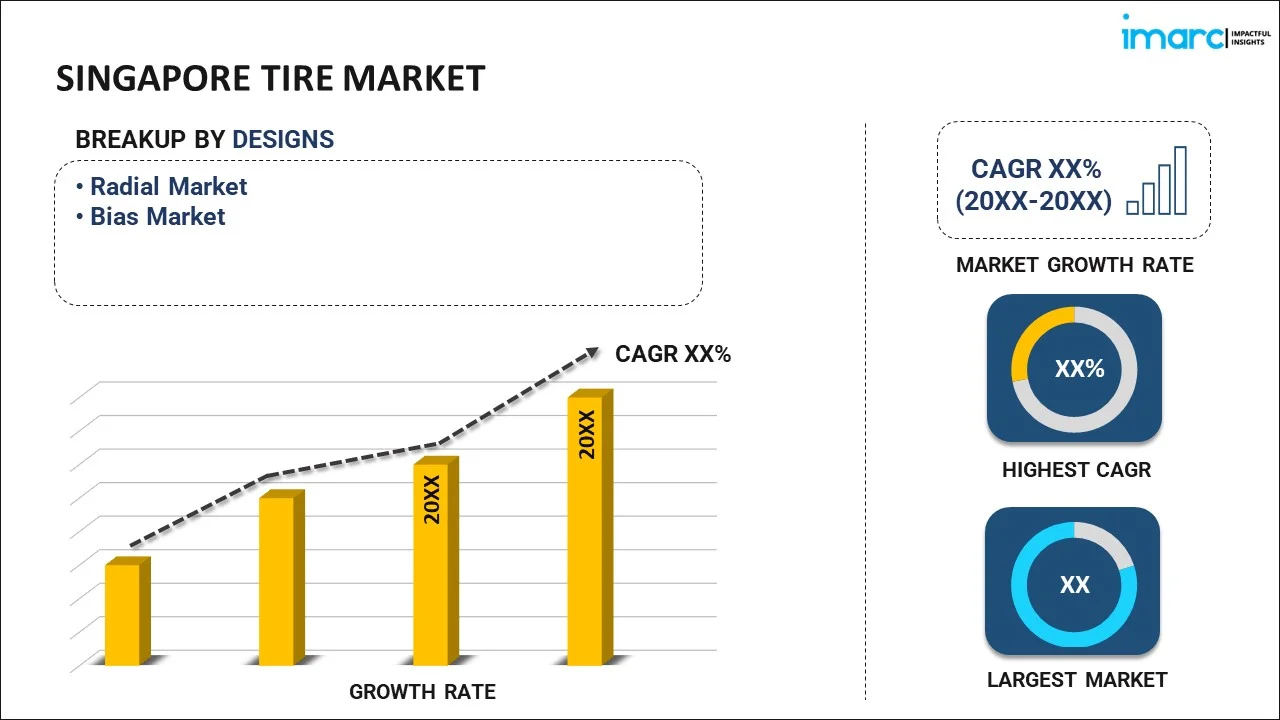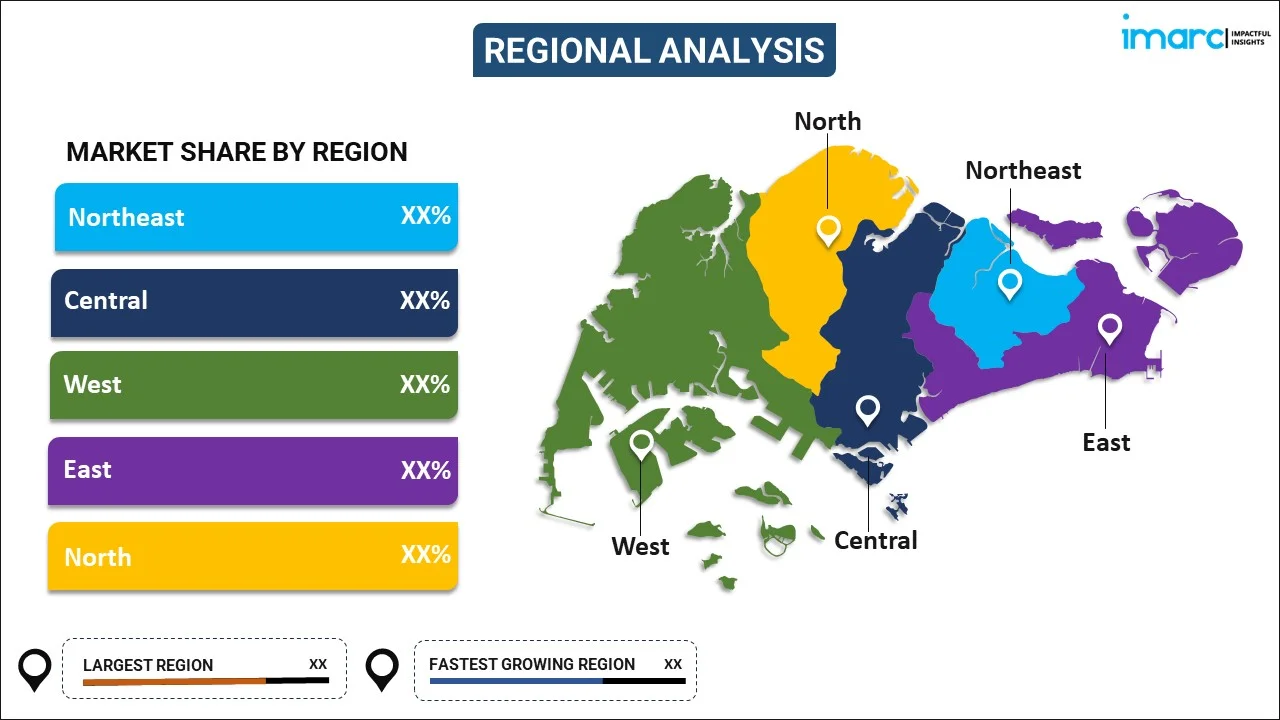
Singapore Tire Market Report by Design (Radial Market, Bias Market), End-Use (OEM Market, Replacement Market), Vehicle Type (Passenger Cars, Light Commercial Vehicles, Medium and Heavy Commercial Vehicles, Two Wheelers, Three Wheelers, Off-The-Road (OTR)), Distribution Channel (Offline, Online), Season (All Season Tires, Winter Tires, Summer Tires), and Region 2024-2032
Singapore Tire Market Overview:
The Singapore tire market is projected to exhibit a growth rate (CAGR) of 4.20% during 2024-2032. The increase in vehicle sales, rising automotive production, expanding fleet services, significant technological advancements in tire design, robust infrastructure development, growing demand for tire replacements, and the implementation of stringent safety regulations are some of the key factors bolstering the market growth.
|
Report Attribute
|
Key Statistics
|
|---|---|
|
Base Year
|
2023 |
|
Forecast Years
|
2024-2032
|
|
Historical Years
|
2018-2023
|
| Market Growth Rate (2024-2032) | 4.20% |
Singapore Tire Market Trends:
Increasing vehicle ownership in Singapore:
As the economy grows and the standard of living improves, more individuals and families are purchasing personal vehicles. The number of registered vehicles in Singapore stood at 850,921 units by April 2024. This surge in vehicle ownership boosts demand for both original equipment (OE) tires and replacement tires. Additionally, the government's policies supporting car ownership and the development of urban infrastructure have facilitated greater mobility, further stimulating tire consumption. The rise in ride-sharing services and the expansion of fleet services for taxis and delivery vehicles also contribute to the growing demand for tires, as these vehicles experience higher usage rates and require more frequent tire replacements. Consequently, as more people seek the convenience and flexibility of personal and shared vehicle use, there will be a steady demand for tires in Singapore.
Rise of electric vehicles (EVs):
As part of its Green Plan 2030, the Singapore government is promoting the adoption of electronic vehicles (EVs) to reduce carbon emissions and improve air quality, which is boosting the demand for specialized tires. This program consists of phasing out internal combustion engine vehicles, investing in infrastructure for charging, and offering incentives to buyers. EVs have different requirements compared to traditional vehicles, necessitating specialized tires that can handle the unique demands of electric propulsion, such as higher torque and increased weight due to battery packs. These tires are designed to offer low rolling resistance to maximize energy efficiency and extend the driving range of EVs. Along with this, the Land Transport Authority (LTA) plans to electrify half of the bus fleet by 2030 and transition to a fully cleaner energy bus fleet by 2040, which will present lucrative opportunities for the tire market.
Advancements in tire technology:
Tire manufacturers are continually developing new materials and designs to enhance tire performance, safety, and sustainability. Innovations such as run-flat tires, which allow vehicles to continue driving after a puncture, and self-sealing tires, which automatically seal small punctures, are gaining popularity among consumers for their convenience and safety benefits. Furthermore, advancements in tread patterns and rubber compounds are improving tire durability, fuel efficiency, and traction, which are crucial for both traditional and electric vehicles. The rising popularity of smart tires, which have sensors to track temperature, wear, and tire pressure in real-time is also contributing to the market growth. Moreover, the surging focus on environmentally friendly and sustainable solutions has resulted in the creation of eco-friendly tires that are made of recyclable materials and meet Singapore's environmental goals, thus aiding in market expansion.
Singapore Tire Market News:
- In March 2023, Triangle Tyre launched two new high-performance tyres in Singapore, the EffeX Sport TH202 and ReliaX Touring TE307. The EffeX Sport TH202 is designed for performance and electric vehicles (EVs), offering a 13% improvement in wet handling and a 28% improvement in wet braking. On the other hand, the ReliaX Touring TE307 targets durability and mileage, providing a 23% improvement in wet braking and a 9% improvement in wet handling.
Singapore Tire Market Segmentation:
IMARC Group provides an analysis of the key trends in each segment of the market, along with forecasts at the country level for 2024-2032. Our report has categorized the market based on design, end-use, vehicle type, distribution channel, and season.
Design Insights:

- Radial Market
- Bias Market
The report has provided a detailed breakup and analysis of the market based on the design. This includes radial market and bias market.
End-Use Insights:
- OEM Market
- Replacement Market
A detailed breakup and analysis of the market based on the end-use have also been provided in the report. This includes OEM market and replacement market.
Vehicle Type Insights:
- Passenger Cars
- Light Commercial Vehicles
- Medium and Heavy Commercial Vehicles
- Two Wheelers
- Three Wheelers
- Off-The-Road (OTR)
The report has provided a detailed breakup and analysis of the market based on the vehicle type. This includes passenger cars, light commercial vehicles, medium and heavy commercial vehicles, two wheelers, three wheelers, and off-the-road (OTR).
Distribution Channel Insights:
- Offline
- Online
A detailed breakup and analysis of the market based on the distribution channel have also been provided in the report. This includes offline and online.
Season Insights:
- All Season Tires
- Winter Tires
- Summer Tires
The report has provided a detailed breakup and analysis of the market based on the season. This includes season tires, winter tires, and summer tires.
Regional Insights:

- North-East
- Central
- West
- East
- North
The report has also provided a comprehensive analysis of all the major regional markets, which include North-East, Central, West, East, and North.
Competitive Landscape:
The market research report has also provided a comprehensive analysis of the competitive landscape. Competitive analysis such as market structure, key player positioning, top winning strategies, competitive dashboard, and company evaluation quadrant has been covered in the report. Also, detailed profiles of all major companies have been provided.
Singapore Tire Market Report Coverage:
| Report Features | Details |
|---|---|
| Base Year of the Analysis | 2023 |
| Historical Period | 2018-2023 |
| Forecast Period | 2024-2032 |
| Units | Billion US$ |
| Scope of the Report | Exploration of Historical Trends and Market Outlook, Industry Catalysts and Challenges, Segment-Wise Historical and Future Market Assessment:
|
| Designs Covered | Radial Market, Bias Market |
| End-Uses Covered | OEM Market, Replacement Market |
| Vehicle Types Covered | Passenger Cars, Light Commercial Vehicles, Medium and Heavy Commercial Vehicles, Two Wheelers, Three Wheelers, Off-The-Road (OTR) |
| Distribution Channels Covered | Offline, Online |
| Seasons Covered | All Season Tires, Winter Tires, Summer Tires |
| Regions Covered | North-East, Central, West, East, North |
| Customization Scope | 10% Free Customization |
| Post-Sale Analyst Support | 10-12 Weeks |
| Delivery Format | PDF and Excel through Email (We can also provide the editable version of the report in PPT/Word format on special request) |
Key Questions Answered in This Report:
- How has the Singapore tire market performed so far and how will it perform in the coming years?
- What has been the impact of COVID-19 on the Singapore tire market?
- What is the breakup of the Singapore tire market on the basis of design?
- What is the breakup of the Singapore tire market on the basis of end-use?
- What is the breakup of the Singapore tire market on the basis of vehicle type?
- What is the breakup of the Singapore tire market on the basis of distribution channel?
- What is the breakup of the Singapore tire market on the basis of season?
- What are the various stages in the value chain of the Singapore tire market?
- What are the key driving factors and challenges in the Singapore tire?
- What is the structure of the Singapore tire market and who are the key players?
- What is the degree of competition in the Singapore tire market?
Key Benefits for Stakeholders:
- IMARC’s industry report offers a comprehensive quantitative analysis of various market segments, historical and current market trends, market forecasts, and dynamics of the Singapore tire market from 2018-2032.
- The research report provides the latest information on the market drivers, challenges, and opportunities in the Singapore tire market.
- Porter's five forces analysis assist stakeholders in assessing the impact of new entrants, competitive rivalry, supplier power, buyer power, and the threat of substitution. It helps stakeholders to analyze the level of competition within the Singapore tire industry and its attractiveness.
- Competitive landscape allows stakeholders to understand their competitive environment and provides an insight into the current positions of key players in the market.
Need more help?
- Speak to our experienced analysts for insights on the current market scenarios.
- Include additional segments and countries to customize the report as per your requirement.
- Gain an unparalleled competitive advantage in your domain by understanding how to utilize the report and positively impacting your operations and revenue.
- For further assistance, please connect with our analysts.
 Inquire Before Buying
Inquire Before Buying
 Speak to an Analyst
Speak to an Analyst
 Request Brochure
Request Brochure
 Request Customization
Request Customization




.webp)




.webp)












